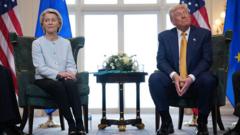European Union leaders are facing growing dissatisfaction with the recently announced trade agreement with the United States, hailed by Donald Trump as a significant win. The agreement, which averted the previously threatened 30% tariffs, applies a 15% tariff on most EU exports, a stark increase from the previous average of 4.8%. While the deal was initially received with relief by some in Europe, many are now expressing dissatisfaction over its implications and the negotiations that remain to be finalized.
European Commission chief Ursula von der Leyen has faced mounting criticism, with leaders emphasizing the necessity for a firmer negotiation stance. Germany's finance minister Lars Klingbeil acknowledged the agreement provides some predictability, albeit noting a preference for a better outcome. "It is good that there is an agreement with the US, that there are no further escalations," he stated, reflecting a common sentiment among European officials.
The legal status of the agreement remains ambiguous, with the European Commission stating that it is not a legally binding document but rather a set of political commitments. Meanwhile, the US administration has presented the deal's achievements as "historic structural reforms," despite admitting that further discussions are still to come. French President Emmanuel Macron highlighted that this agreement is merely the beginning of ongoing negotiations, with expectations of continued discussions on term details.
Discrepancies have also arisen regarding specific sectors affected by the tariffs. The US claims that pharmaceuticals and semiconductors will come under the new tariff, while the EU has asserted that these sectors will maintain their current 0% rate until global tariff rates are resolved. Such differences point to the complexities ahead as both sides seek to clarify their commitments.
The tariff will have a varying impact across EU member states, with Germany, Italy, and Ireland perceived to be the most vulnerable due to their strong ties with the US market. For instance, the German automotive sector heavily relies on exports to the US, fearing significant financial burdens from these new tariffs. In contrast, Ireland, despite expressing cautious acceptance of the deal, stands to face considerable losses in its pharmaceutical exports.
Such economic impacts prompt concerns of disproportionate burden across Europe, compelling calls for compensation from affected sectors, though experts warn against using public funds to alleviate corporate losses as it could empower the narrative surrounding the tariffs. "That would mean that, ultimately, Europeans are paying the price of his tariffs," warned Cinzia Alcidi from the Centre for European Policy Studies.
Thus, while the agreement brings short-term predictability to European businesses, the unresolved details might lead to prolonged negotiations, with EU representatives under pressure to advocate stronger positions as the situation evolves.




















